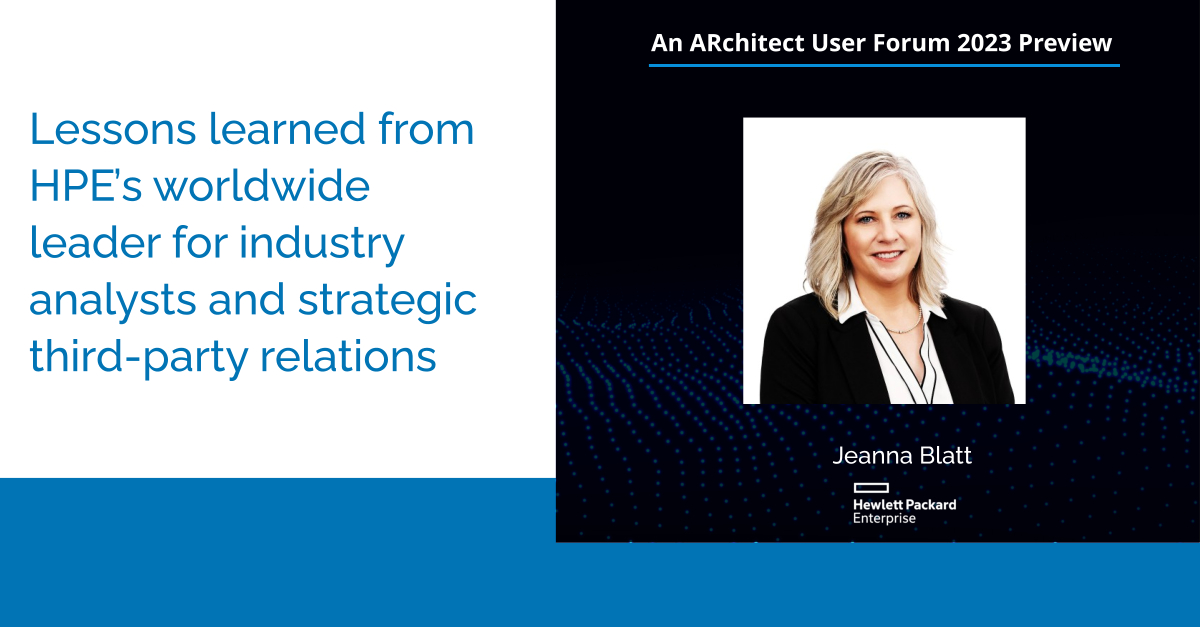Get ready for more analyst relations (AR) knowledge — to help you stay on top of trends, anticipate what’s next, and drive more and new value from AR. We’re back with Part II of our “Profiles in AR” interview with Duncan Chapple, associate director and head of analyst relations for CCgroup.
If you missed Part I, you can check it out here — covering Duncan’s background as an analyst, why many AR efforts get wasted and how to fix that.
Without further ado, here’s the latest installment — with Duncan’s thoughts on recent changes in AR, analyst relations vs. influencer relations, how to drive AR investments in a down economy, and more.
Q: For young companies, or those in emerging markets, how can AR explain to the C-suite why they need to engage with analysts… even if a Magic Quadrant is years away?
Duncan: That’s a good question. And there are three things to explain:
First, analyst relations is primarily not about the MQ. Analysts are so much more influential in their spoken word interactions than they are in Magic Quadrants. If you speak to an analyst who has written an MQ, you’ll find that most of what they say is not perceivable in the evaluation. So, very often, the MQ fetish is an internal drive of the vendor and not really an objective need of the market.
That’s why it’s vital to map AR to your business’s strategy — looking at its targets and then talking about the value AR can produce relative to those. You’ll see lots of AR value for our traditional communications stakeholders, but there’s more available for colleagues elsewhere.
The second thing I’d say, especially for startups, is you’re probably going to go through a funding round or some kind of M&A activity. Those are surrounded by extensive due diligence. It’s 101% certain that analysts will be sought after and involved — talking to potential investors about the market and companies in the transaction. This process highlights the value of a foundational AR program that’s focused on awareness and includes one-to-many communications — because that builds up that Hansel-and-Gretel sprinkling of crumbs throughout the forest, to help people find you.
And the third major benefit is getting analyst insights. Very often, high-growth vendors solve specific use cases but don’t understand the structure of their market more broadly. Maybe they’re very successful with a handful of customers. The customers appreciate that those companies are “weird” and provide a different value curve. But those customers are weird too; they’re not like most of the market. When technology providers don’t understand the structure of the full competitive market, they may think people aren’t buying because they’re ignorant — when, in fact, they’re not buying because they’re on some other agenda, exploring some other value proposition. Analysts understand all that, as they have a broad market overview.
That’s one reason why vendor and analyst viewpoints clash, and this produces tension. They often have differing opinions because they’re coming at the market from different perspectives. It’s like, if I’m in New York and you’re in Seattle, and we both want to go to Chicago. It’s bad advice for me to tell you to drive west, just because that’s the right direction for me — you’re going to get super-wet.
But vendors can struggle to understand why analysts have different views, with some vendors thinking the analysts just don’t get it or are in the market leader’s pocket. The antagonism can be profound, but it doesn’t have to be there. There’s a great opportunity for both parties to learn from one another and have mutually beneficial relationships. Companies can not only help analysts understand what they (and their customers) see; they can also benefit greatly from analysts’ insights too.
Q: How has the practice of analyst relations changed in recent years?
Duncan: I think every strength is its own weakness. For example, the best practices in analyst relations are essentially the same now as in the late 20th century.
And any profession that tries to stabilize itself consolidates a body of knowledge, which is essentially technique. But these techniques are now the bare minimum: Best practice is not enough for what we need to do.
So sure, AR people still face the need to make fewer, bigger bets — that is, really focusing on the specific analysts they want to engage, at the expense of others who are less influential. But so many other topics now merit AR’s attention: diversity, the environment, inclusion and the tech market’s moral duties.
These have always been issues. But now, they are factors in so many purchasing processes, and so now most analysts have to consider at least one of them even if it’s not their specialization. They are issues that analysts are speaking about. And to reach analysts and influencers on broad, social topics like these, classic content marketing techniques need to become woven into analyst relations. So, in addition to their fewer, bigger bets, analyst relations programs need to focus on one-to-many content strategies as well.
And that’s become especially important as the buying process itself has changed. Buyers are involving vendors later and later in the purchase journey, and even involving analysts later too. Because there’s so much buyer self-service, vendor-funded content and user reviews are more important than ever, and AR is increasingly involved in these areas.
So, I think that one big opportunity is to not just move into content marketing tactically but to think of it strategically. AR has to change from broadcasting about vendors to being a passionate partisan who loves to solve buyers’ problems. Doing that is so much easier if you think of AR as an integrated marketing activity, rather than a beautiful little island that has to be separate from other communications disciplines. That’s not the way we win; we win by mastering the customer conversation.
Q: How do you distinguish influencer relations from analyst relations? Are the areas merging?
Duncan: Well, one thing I’ll say is that not all non-analyst influencers are equal. So, one of the frameworks that we’ve found really useful is the PESO approach — looking at paid, earned, shared and owned content. When an influencer covers or discusses you, where does that coverage sit?
Generally, in marketing, when folks talk about influencers, we mean people incentivized, and often paid, to advocate your solution. And that’s a different kind of influencer relations than we do in B2B analyst relations. Analyst relations are earned; AR techniques don’t really transfer to influencers who expect to be paid.
With B2B influencers, the difference between being paid and not paid is kind of a continuum. Some management consultants, for example, will only meet you if they want to resell your solution and get a cut — so there are shades of commercial alignment. And the more commercially aligned the thought leader needs to be to take you seriously, the less useful analyst relations approaches are.
But when we’re talking about primarily non-paid B2B influencers, who are often thought-leaders and opinion leaders, more broadly — including academics, experts, journalists, regulators, consultants, and so on — then you can apply techniques similar to analyst relations.
It’s very useful to see these influencers counted in ARchitect. Content marketing works well with many of these people. And so if you decompose analyst relations into one-to-one and one-to-many activities, the one-to-many techniques work well with other thought-leaders. But one-to-one communications with influencers across the “non-paid-to-paid continuum” often require different approaches.
As analyst relations teams look at how and whether to engage non-analyst influencers, I think they have a tough choice. Whichever choice you make is painful. You can say, “Yes, we will take responsibility for opinion leaders.” But then you’re putting on your plate something for which you may not be successful, that’s going to be more difficult than analyst relations and has diminishing returns to scale. You’ll see inefficiencies rather than synergies, because these influencers are often less responsive than analysts, and relevance is harder to prove.
The other side of it is that it can allow you to conquer “white space” — audiences that, in some organizations, no one is looking after, like management consultants, resellers, and opinion leaders, more broadly. So, we can allow AR to widen and expand its outreach to more audiences, uplifting awareness among key thought leaders. And when you do that, it’s important to define the benefits to your that business that you’re seeking, even beyond awareness. CCgroup uses HubSpot to measure content marketing engagement in a deep way: looking at dwell times, forwarding, downloads, etc. This requires experts because, at the end of the day, not all engagement is action.
So when you engage non-analyst opinion leaders, make sure to have a clear understanding of the strategy, targets and business benefits you’re hoping to achieve, so you’re not just adding on more activity and responsibility without clear goals to measure.
Q: What is the Analyst Relations Forum? How are you involved in it, and why should AR pros attend?
Duncan: The Analyst Relations Forum is dedicated to discussing analysts’ impact and the role that analyst relations plays in contributing to business success. It provides a framework for moving AR best practice to “next practice” — something important that isn’t often talked about.
The forum is 10 years old; I helped launch it when I was working at Kea Company. Kea, CCgroup, SageCircle and the Association for Analyst Relations Partnership — the biggest AR group on LinkedIn — are the forum sponsors.
Back in the day, we organized the Analyst Relations Forum as a series of face-to-face meetings, held at King’s College London, in its stunning building overlooking the River Thames.
When the pandemic happened, we shifted to an online forum, collaborating with like-minded organizations, including the Analyst Observatory (part of the University of Edinburgh Business School) and SageCircle. Last summer, we had about 1,400 registrations across the eight-day, online event. We’ll hold an online forum again this year, the last week in June.
And we supplement the online forum with in-person, boardroom discussions; our most recent one was in London on April 20. These are off-the-record, intensive discussions… and they can get quite heated at times! That’s because no single perfect template for an analyst relations program exists: Organizations have different strategies and want different things from AR. Because of that, different analyst relations programs respond to different value curves and have specific activities, plans, stakeholders and metrics.
When we bring AR people together — who often come into the meetings thinking it’s simply a question of whether their program is better or worse than others — they often see they can improve in other directions. That opens up a whole new vista. It allows people to see not just where they can strengthen their current activities, but also that they can run a program that produces totally different value for their organization.
Q: You mentioned the University of Edinburgh’s Analyst Relations Observatory. Can you tell us a little more about that?
Duncan: Certainly. The observatory is about six years old. I’m one of the co-directors, working alongside Neil Pollock, a professor of innovation and social informatics, and Dr. Teea Palo, a senior lecturer in marketing.
The Analyst Observatory conducts global research about analyst activities and the use and impact of analyst research — often publishing the results in academic journals. We’ve done qualitative interviews with analysts about the information they use to structure markets, and what vendors talk about vs. what analysts want to hear. Through the Observatory, I had the opportunity to travel to the States and spend a month working in Gideon Gartner’s personal archive — looking at the birth of Gartner, the creation of Magic Quadrants, and so on.
We also did an exceptionally deep study of companies named Cool Vendors by Gartner — what did they do with that designation, and how did it help them?
The business school students are involved in the research projects too. For example, one of the master’s students helped study the anatomy of analyst briefings, and showed that small talk is incredibly important.
And more recently, the Analyst Observatory has been working with Robin Schaffer and Chris Holscher to study how startups engage with analysts, and the impact that engagement has. It’s been exciting because people often think of analyst firms as a tool for the late-stage majority… that analysts are only influential on, and useful for, organizations paying $100,000 or more to subscribe.
But that’s not true — and it hasn’t been for 20 years. Analysts are influencing those outside their subscriber base. And their research is accessible to all types of companies; it’s hard to find a Magic Quadrant or Forrester Wave that’s not licensed and freely available these days. Not to mention, more people are reading Peer Insights reviews (which are free) than Magic Quadrants anyway.
So looking into this widening diffusion of analyst insight — and seeing the way analysts themselves have pivoted to pay more attention to scale-ups and start-ups — is incredibly exciting for us.
Q: In today’s economy, how can AR pros best demonstrate their value to drive continued investments in their programs?
Duncan: I’m not seeing AR budgets being cut across the board, though some are being cut. And those ones are usually in programs that have not sat down and said: “What is our business’s objective? What targets can drive those objectives? How can we quantify the benefits of our program and report them back?”
So, firstly, you need to do that. You need to better understand the different values that you’re providing to stakeholders and build a scorecard that measures those. In all the analyst relations programs we run at CCgroup, we’re measuring at least five key performance indicators, because no clients want just one thing from analyst relations. When you measure and can report success across multiple dimensions, it’s easier for companies to not just defend AR resources but also extend them.
And the second thing we all have to admit is that buying things from analyst firms is not an analyst relations activity. We’re not building a relationship with an analyst when we buy more from their employer. I was speaking to somebody last week who said they’re spending $1.8 million annually on analyst relations. But of course, it turned out they’re not really spending $1.8 million on relationships with analysts, are they? They’re spending most of that on analyst content and with just one firm.
So there’s a good opportunity to “rightsize”: In the same way you should align your time and outreach with the influence a firm has, you may want to also consider mapping the money you spend with individual firms in a way that’s commensurate with their level of influence. This would almost definitely mean spending more with Tier II and Tier III targets.
And, in particular, analyst research spending should be carefully reconsidered. If your business is only buying research so your analyst relations people can read it, that’s not a strong business case. Don’t buy anything unless it’s useful to the business. Plus, as I mentioned, there’s so much analyst research that you can access in the public domain.
I think a lot of technology providers are dramatically overspending with analyst firms in the belief that it’s an analyst relations activity in itself. This sustains the myth that early-stage companies shouldn’t do analyst relations because they can’t afford a Gartner or Forrester subscription. That’s just not true.
Overspending also feeds the myth that AR people’s primary job is consuming analyst research and repeating it back to colleagues. That’s not the primary task of analyst relations. Analyst relations is about shifting analysts’ perceptions — spending money passively does not shift perceptions. You might turn your account manager into your best friend because she got more commission and could buy her niece a 70-inch TV to take to college, but at the end of the day, you’re not building better relationships with analysts. So, focus time and money on what counts: building better relationships and influencing perception.
***
Many thanks to Duncan for sharing his insights! If you’d like to connect with Duncan, you can reach him on LinkedIn.
And stay tuned for future Profiles in AR!




